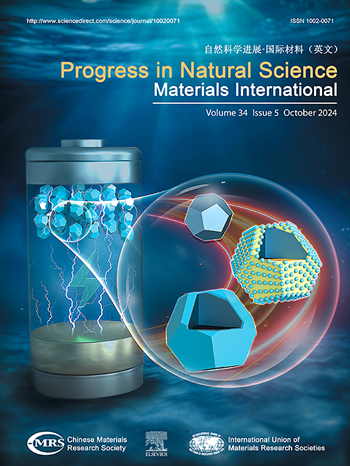High temperature liquid shock manufacturing of RuNi catalysts for hydrogen evolution reaction
IF 4.8
2区 材料科学
Q2 MATERIALS SCIENCE, MULTIDISCIPLINARY
Progress in Natural Science: Materials International
Pub Date : 2024-10-01
DOI:10.1016/j.pnsc.2024.07.012
引用次数: 0
Abstract
Rational design and production of materials for highly effective and environmental-friendly electrocatalytic hydrogen evolution reaction (HER) play a pivotal role in advancing renewable energy utilization. Structural engineering of noble metal nanomaterials can significantly boost catalytic performance through atomic rearrangement, electronic structure modification and surface reactivity modulation. Here, RuNi alloy is synthesized using a novel high temperature liquid shock method (HTLS) with instant Joule heating treatment at 1073 K under the mixed atmosphere of Argon (Ar) and CO. The synthesis process involves an aqueous solution containing metal precursors, capping agents, reductant agents and carbon black. Particularly, the as-prepared RuNi-HTS nanostructures with hexagonal close-packed (hcp) phase demonstrate impressive electrocatalytic HER activity in alkaline conditions, requiring only 28 mV of overpotentials at a current density of 10 mA cm−2. Note that the Tafel slope is 159.2 mV dec−1. Furthermore, this versatile HTLS method can be extended to synthesize other catalysts, including Ru-HTS, PtRu, and PtZn, all of which show commendable performance for HER as well. This study lays the groundwork for the strategic design and high-throughput synthesis of novel materials with fine-tuned structure and refined size, enabling highly efficient and environmental-friendly electrocatalysis.
用于氢进化反应的 RuNi 催化剂的高温液态冲击制造技术
合理设计和生产高效、环保的电催化氢进化反应(HER)材料在推进可再生能源利用方面发挥着关键作用。贵金属纳米材料的结构工程可以通过原子重排、电子结构改性和表面反应活性调制来显著提高催化性能。本文采用新型高温液态冲击法(HTLS),在氩气(Ar)和二氧化碳(CO)混合气氛下于 1073 K 温度下进行瞬间焦耳加热处理,合成了 RuNi 合金。合成过程涉及含有金属前体、封端剂、还原剂和炭黑的水溶液。特别是所制备的具有六方紧密堆积(hcp)相的 RuNi-HTS 纳米结构在碱性条件下表现出令人印象深刻的电催化 HER 活性,在 10 mA cm-2 的电流密度下仅需要 28 mV 的过电位。请注意,塔菲尔斜率为 159.2 mV dec-1。此外,这种多用途 HTLS 方法还可扩展用于合成其他催化剂,包括 Ru-HTS、PtRu 和 PtZn,所有这些催化剂在 HER 方面也都表现出令人称道的性能。这项研究为具有微调结构和精细尺寸的新型材料的战略设计和高通量合成奠定了基础,从而实现高效环保的电催化。
本文章由计算机程序翻译,如有差异,请以英文原文为准。
求助全文
约1分钟内获得全文
求助全文
来源期刊
CiteScore
8.60
自引率
2.10%
发文量
2812
审稿时长
49 days
期刊介绍:
Progress in Natural Science: Materials International provides scientists and engineers throughout the world with a central vehicle for the exchange and dissemination of basic theoretical studies and applied research of advanced materials. The emphasis is placed on original research, both analytical and experimental, which is of permanent interest to engineers and scientists, covering all aspects of new materials and technologies, such as, energy and environmental materials; advanced structural materials; advanced transportation materials, functional and electronic materials; nano-scale and amorphous materials; health and biological materials; materials modeling and simulation; materials characterization; and so on. The latest research achievements and innovative papers in basic theoretical studies and applied research of material science will be carefully selected and promptly reported. Thus, the aim of this Journal is to serve the global materials science and technology community with the latest research findings.
As a service to readers, an international bibliography of recent publications in advanced materials is published bimonthly.

 求助内容:
求助内容: 应助结果提醒方式:
应助结果提醒方式:


